Sixty-Five-Year-Old Jockey Dies After Being Thrown From His Mount in the Starting Gate - USVI
NIOSH In-house FACE Report 2007-04
October 19, 2009
Summary
On February 18, 2007, a 65-year-old male jockey (the victim) died after being thrown from his mount in the starting gate during the start of a race. The victim and his mount were being led into the eighth stall of an eight-stall mobile starting gate. As this was being done, the horse in the fifth stall of the starting gate reared up and struck the door of the starting gate. All eight stall gates opened simultaneously. A review of a videotape of the start of the race indicated that the victim had not completely settled onto his mount when the horse in the fifth stall broke for the start of the race. The victim was thrown backward and seemed to hit his head on the back door of the gate stall. Since the horses would have to pass the location of the starting gate to complete the race, the starting gate had been hooked to a tractor for quick removal from the track. When the tractor operator saw the horses break from the starting gate, he began to pull the starting gate from the track. When other track workers saw the horse without its rider, they signaled for the tractor operator to stop. The starting gate, which had been pulled up onto the trunk of the jockey, was pushed backward. Rescue personnel stationed in an ambulance at the track responded immediately. The victim was transported to the hospital where he died in surgery approximately four hours after the incident. It could not be determined whether the starting gate had opened due to the horse bolting against the gate in the fifth stall, or due to being opened by the starting gate operator. NIOSH investigators concluded that, to help prevent similar occurrences, track operators should:
- Designate sufficient spotters located at the front and rear areas of both sides of the starting gate to ensure that all horses and their riders have cleared the starting gate area prior to moving the starting gate in any direction.
- Establish a preventive maintenance program for the track’s starting gate that would require periodic inspection, pre-race testing, and maintenance of the gate’s hydraulic system to ensure proper function
- Consider evaluating equipment such as starting gates to ensure that jockeys and horses are provided a safe work environment.
- Ensure that jockeys wear Personal Protective Equipment (PPE) such as helmets and vests that are properly fitted and in good condition.
Introduction
On February 18, 2007, a 65-year-old male jockey (the victim) died after being thrown from his mount in the starting gate during the start of a race. The starting gate was inadvertently pulled partially over the victim while being pulled from the track by a tractor. On February, 22, 2007, the National Institute for Occupational Safety and Health (NIOSH), Division of Safety Research (DSR), learned of the incident by a news network and island newspaper clippings. On March 20-22, 2007, a DSR Senior Investigator and Research Epidemiologist conducted an investigation of the incident. The incident was reviewed with the racetrack general manager, the grounds superintendent, and two workers present at the track when the incident occurred. Photographic documentation of the track and starting gate were taken. The incident was also discussed with island police investigators. A video of the start of the race was viewed.
Racing was conducted at the track sixteen weekends a year and had been under the present management since January of 2005. The racetrack had a basic written safety program for the 25-30 laborers that worked at the track on racing weekends that performed duties such as track maintenance, assisting with the horses, and barn maintenance. Additionally, 18 employees performed duties involved with wagering on daily, year-round stateside simulcast thoroughbred, greyhound, and harness racing. The track had four barns (Photo 1) that could house approximately 100 horses during racing weekends. Some horses were local, while some were brought by barge from other islands during racing weekends. Jockeys were either from Puerto Rico (including the victim), local riders, or were stateside riders. The victim had been racing for forty years and had traveled from his home in Puerto Rico to the island racetrack for the past twenty years on racing weekends. His home racetrack stated that he had raced for more than 1,400 victories. Ten races were to be held on the day of the incident. The victim was preparing to race in the seventh race when the incident occurred. He had ridden in the second race earlier in the day without incident. A second rider was thrown from his mount during the second race of the day; he had been transported to the hospital where he was treated and released for minor injuries.
The race track involved in the incident was seven furlongs (4,620 feet) in circumference. The dirt racing surface was sixty feet wide. The surface of the track consisted of a mixture of sand, clay, and treated dirt (Photo 2). The hours of operation for use of the track by trainers and practice riders were from 4:00am until 10:00am and again from 3:00pm until 6:00pm daily after racing was completed. Races were conducted in one mile, one mile and an eighth, and one mile and a half distances.
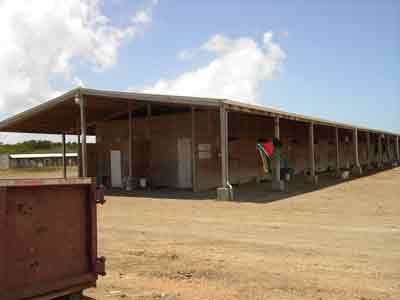
|
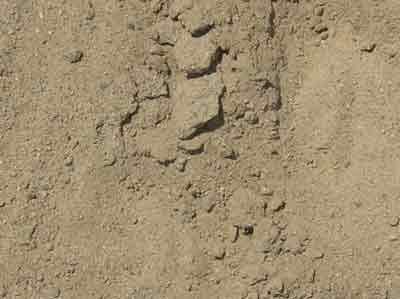
|
|
Photo 2. Track surface |
The track surface was maintained daily in the following manner:
- After the track surface closed, the surface was thoroughly wet down by a 4000-gallon capacity water truck
- A harrow was then used to maintain and level the racing surface.
- At the end of the harrowing process, the track was packed and sealed by a packer
- Prior to the opening of the track surface, the surface was harrowed for the practice riders and horses
- Once the surface closed the maintenance process is repeated
- After racing is completed, the process was again repeated
No maintenance schedule existed for the starting gate and the age of the starting gate could not be determined. No documented evidence existed as to when the starting gate had last been inspected or when maintenance had last been performed on the starting gate. The water truck, harrow, track conditioner, packer, and tractor looked to be well maintained. The tractor and conditioner had been purchased new six months earlier. This was the first fatality that occurred at the track under the present management. In 1979, a jockey died after being thrown from his mount during a race.
Investigation
When the jockeys arrived at the track on racing weekends, they proceeded to the jockeys’ quarters (Photo 3) where they dressed in their racing silks and helmets and were weighed by the grounds superintendent. Safety vests were not required.
The jockeys would then leave their quarters and proceed to the paddock area (Photo 4) where the horses for the next race were being saddled and prepared for the race. The horse owners were present in the paddock area and would then hire the jockey of their choice at a mutually agreed upon fee.
The jockeys would then mount their horses and proceed through the track infield to the starting gate area where the hoses were loaded into the gate and shut into the gate one at a time by their handlers and track personnel. The horses were loaded into the starting gate stalls as quickly as possible, some simultaneously, to minimize the time in the starting gate. This lessened the exposure to injury to horse and rider in the stalls should a horse become agitated and start to rear in the stall. Once the horses and riders entered the starting gate, a spotter positioned behind the starting gate signaled the tractor operator. Once the tractor operator received this signal, he pulled the lever to engage the gate’s hydraulics which opened the gates. He then pulled the starting gate onto the track infield.
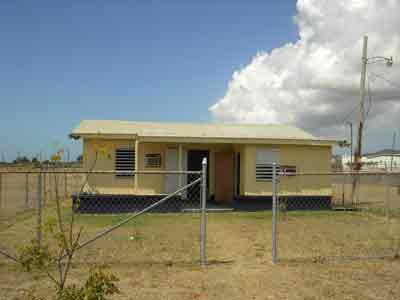 |
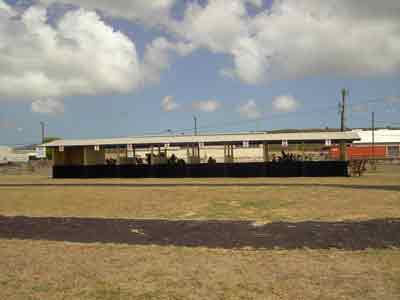 |
|
Photo 4. Paddock area |
The victim was to race from the eighth and final stall to be loaded. As the victim was beginning to mount his horse, the horse in the fifth stall reared against the starting gate’s fifth stall’s door (Photo 5). The door was pushed open slightly, then the entire starting gate’s doors opened.
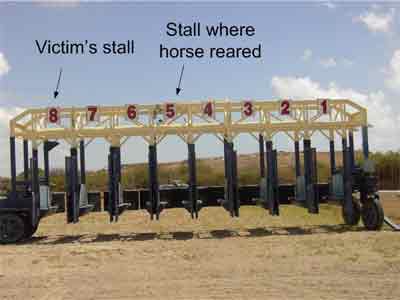 |
|
Photo 5. Front of the starting gate |
The video tapes of the start of the race indicated that the victim had not completed mounting his horse when the starting gate opened and was thrown backward from his horse when the horse broke for the start of the race. The victim may have struck his head on the steel rail at the top of the stall’s rear door, stunning him. The victim fell to the track surface.
When the tractor operator saw the horses break for the start of the race, he started the tractor and began to pull the starting gate off the track. Track workers saw the victim lying on the ground and signaled the tractor operator to stop; however, at that time the starting gate had been pulled partially onto the victim. The starting gate was immediately backed off the victim.
Rescue personnel stationed in an ambulance at the track responded immediately and began to treat the victim. Three additional ambulances and a rescue unit arrived shortly after the incident. The victim was transported to the local hospital where he died approximately four hours later while in surgery to repair a ruptured spleen. The victim had also suffered several broken ribs.
Back to Top
Cause of Death
The death certificate listed the cause of death as complications during surgery to repair a lacerated spleen.
Recommendations/Discussion
Recommendation #1: Track operators should designate sufficient spotters located at the front and rear areas of both sides of the starting gate to ensure that all horses and their riders have cleared the starting gate area prior to moving the starting gate in any direction.
Immediately after the horses broke from the starting gate, the tractor operator began to pull the starting gate across the racetrack. It was not until he looked back and he heard other track workers yelling that he noticed one of the horses was riderless. He then saw the victim on the ground with the starting gate partially across the victim’s chest. Sufficient spotters located at the front and rear areas of both sides of the starting gate could maintain visual contact with all riders and examine each stall after the race’s start to determine that all riders had cleared the starting gate. The spotters could then signal the tractor operator to pull the starting gate from the track.
Recommendation #2: Track operators should establish a preventive maintenance program for the track’s starting gate that would require periodic inspection, pre-race testing, and maintenance of the gate’s hydraulic system to ensure that it was functioning properly.
Discussion: The racetrack had no preventive maintenance program in place. A scheduled periodic preventive maintenance program would assure that all equipment and machinery would be inspected and maintained on a regular basis. It could also detect problems before individuals are exposed to possible injury. For the starting gate, this program could include a pre-race visual inspection of the starting gate, periodic inspection of the starting gate’s hydraulic system, and a pre-race testing of the starting gate’s operating system.
Although it could not be determined whether or not the starting gate malfunctioned, a periodic preventive maintenance program for all machinery and equipment at the track could detect problems that might lead to premature gate openings before an incident or injury occurs. When tested after the incident, the gate functioned properly.
Recommendation #3: Track owners should consider evaluating equipment such as starting gates to ensure that jockeys and horses are provided a safe work environment.
Discussion: The insides of the starting gate in this incident were padded, the front and back opening gates were not. Track owners should evaluate equipment such as starting gates and determine if the existing padding would sufficiently protect horses and jockeys, then add padding as necessary.1 A completely padded stall could offer several benefits. It would:
- Help prevent injuries to riders and horses or gate crew when thrown from or into a horse, or pinned by a horse
- Help prevent horses rearing in the gate hitting the hind poles and being injured
- Help prevent riders from hitting the front poles when leaving the starting gate
- Help provide sure footing for assistant starters standing on the gate sides
- Help protect horses from injury by dissipating focal forces over a wide surface area
- Help calm horses entering or standing in the starting gate by covering the cold, hard metal surface with a soft pad.
Although the rider would have still struck his head on the top of the rear door and fallen in this case, if the door had been padded, the rider may have been able to maintain sufficient control of his faculties to avoid the moving starting gate.
Recommendation #4: Track operators should ensure that jockeys wear Personal Protective Equipment (PPE) such as helmets and vests that are properly fitted and in good condition.1
Discussion: Race track operators should require that jockeys wear PPE such as helmets and vests and ensure that this PPE is properly fitted and in good condition. The jockey in this incident was wearing a protective helmet, yet was still incapacitated when his head struck the rear of the starting gate. The victim was not wearing a protective vest. It is not known if a protective vest would have prevented this fatality, but it may have lessened the extent of the damage done to the victim’s internal organs.
References
- NIOSH [2009]. Hendricks et al. An overview of safety and health for workers in the horse-racing industry. Cincinnati, OH: U.S. Department of Health and Human Services, Public Health Service, Centers for Disease Control and Prevention, National Institute for Occupational Safety and Health, DHHS (NIOSH) Publication No. FACE 2009-128.
Investigator Information
This investigation was conducted by Virgil Casini, Senior Investigator, Fatality Investigations Team, Surveillance and Field Investigations Branch, Division of Safety Research.
|
Fatality Assessment and Control Evaluation (FACE) Program The National Institute for Occupational Safety and Health (NIOSH), an institute within the Centers for Disease Control and Prevention (CDC), is the federal agency responsible for conducting research and making recommendations for the prevention of work-related injury and illness. In 1982, NIOSH initiated the Fatality Assessment and Control Evaluation (FACE) Program. FACE examines the circumstances of targeted causes of traumatic occupational fatalities so that safety professionals, researchers, employers, trainers, and workers can learn from these incidents. The primary goal of these investigations is for NIOSH to make recommendations to prevent similar occurrences. These NIOSH investigations are intended to reduce or prevent occupational deaths and are completely separate from the rulemaking, enforcement and inspection activities of any other federal or state agency. Under the FACE program, NIOSH investigators interview persons with knowledge of the incident and review available records to develop a description of the conditions and circumstances leading to the deaths in order to provide a context for the agency’s recommendations. The NIOSH summary of these conditions and circumstances in its reports is not intended as a legal statement of facts. This summary, as well as the conclusions and recommendations made by NIOSH, should not be used for the purpose of litigation or the adjudication of any claim. For further information, visit the program website at www.cdc.gov/niosh/face/ or call toll free at 1-800-CDC-INFO (1-800-232-4643). |
